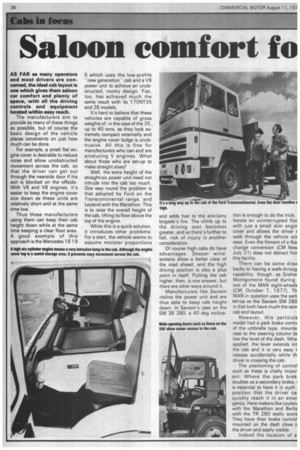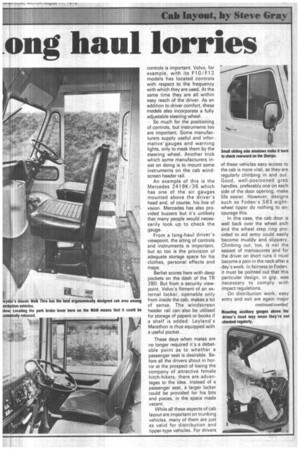Saloon comfort fo ng haul lorries
Page 38

Page 39

Page 40

If you've noticed an error in this article please click here to report it so we can fix it.
AS FAR as many operators and most drivers are concerned, the ideal cab layout is one which gives them saloon car comfort and plenty of space, with all the driving controls and equipment located within easy reach.
The manufacturers aim to provide as many of these things as possible, but of course the basic design of the vehicle places constraints on just how much can be done.
For example, a small flat engine cover is desirable to reduce noise and allow unobstructed movement across the cab, so that the driver can get out through the nearside door if his exit is blocked on the offside. With V6 and V8 engines, it's easier to keep the engine cover size down as these units are relatively short and at the same time low.
Thus those manufacturers using them can keep their cab height down while at the same time keeping a clear floor area. A good example of this approach is the Mercedes 16 19 S which uses the low-profile "new generation" cab and a V6 power unit to achieve an unobstructed, roomy design. Fiat, too, has achieved much the same result with its 170NT35 and 26 models.
It's hard to believe that these vehicles are capable of gross weights of, in the case of the 35, up to 40 tons, as they look extremely compact externally and the engine cover bulge is unobtrusive. All this is fine for manufacturers who can and are producing V engines. What about those who are set-up to make straight sixes?
Well, the extra height of the straight-six power unit need not intrude into the cab too much. One way round the problem is that adopted by Ford on the Transcontinental range, and Leyland with the Marathon. This is to raise the overall height of the cab, lifting its floor above the top of the engine.
While this is a quick solution, it introduces other problems. For a start, the vehicle seems to assume monster proportions and adds fuel to the anti-lorry brigade's fire. The climb up to the driving seat becomes greater, and as there's further to fall, risk of injury is another consideration.
Of course high cabs do have advantages. Deeper windscreens allow a better view of the road ahead, and the high driving position is also a plus point in itself. Putting the cab higher, then, is one answer, but there are other ways around it.
Manufacturers like Saviem incline the power unit and are thus able to keep cab height down. In Saviern's case on the SM 36 280, a 40 deg inclina tion is enough to do the trick. 'eaves an uninterrupted floc with just a small slim engin cover and allows the driver t walk through the vehicle wit ease. Even the fitment of a floc change conversion (CM New July 21) does not detract fror this facility, There can be some dray backs to having a walk-throug capability, though, as Grahar Montgomerie found during test of the MAN eight-wheel€ (CM, October 7, 1977). Th MAN in question uses the sam set-up as the Saviem SM 280 in that both have much the sam cab and layout.
However, this particula model had a park brake contrc of the umbrella type, mounte. near to the steering column bc low the level of the dash. Whe applied, the lever extends int the cab and it is very easy t release accidentally while th driver is crossing the cab.
The positioning of control such as these is vitally impor. ant. Where the park braki doubles as a secondary brake, i is essential to have it in such ; position that the driver cal quickly reach it in an emer gency. Here makers like Leylani with the Marathon and Berlie with the TR 280 really score They have their brake control mounted on the dash close ti the driver and easily visible.
Indeed the location of a controls is important. Volvo, for example, with its F10 / F12 models has located controls with respect to the frequency with which they are used. At the same time they are all within easy reach of the driver. As an addition to driver comfort, these models also incorporate a fully adjustable steering wheel.
So much for the positioning oficontrols, but instruments too are important. Some manufacturers supply useful and infor-. mative• gauges and warning lights, only to mask them by the steering wheel. Another trick which some manufacturers insist on doing is to mount some instruments on the cab windscreen header rail.
An example of this is the Mercedes 2419K/36 which has one of the air gauges mounted above the driver's head and, of course, his line of vision. Mercedes has also provided buzzers but it's unlikely that many people would necessarily look up to check the gauge.
From a long-haul driver's viewpoint, the siting of controls and instruments is important, but so too is the provision of adequate storage space for his clothes, personal effects and maps.
Berliet scores here with deep pockets on the dash of the TR 280. But from a security viewpoint, Volvo's fitment of an external locker, openable only from inside the cab, makes a lot of sense. The windscreen header rail can also be utilised for storage of papers or books if a shelf is added. Leyland's Marathon is thus equipped with a useful pocket.
These days when mates are no longer required it's a debatable point as to whether a passenger seat is desirable. Before all the drivers shout in horror at the prospect of losing the company of attractive female hitch-hikers, there are advantages to the idea. Instead of a passenger seat, a larger locker could be provided for his bits and pieces, in the space made vacant.
While all these aspects of cab layout are important on trunking vehicles, many of them are just as valid for distribution and tipper-type vehicles. For drivers considerations. The UK volume producers Ford, Leyland, Chrysler and Bedford all have cab designs which make the driver's lot easier, although some — notably the Bedford — are getting a bit long in the tooth. Most are built around the concept of a tilt cab mounted forward of the engine. This allows the seats to be fitted above the wheel arches and there is little or no intrusion into the cab.
An option on the Ford DSeries is a kerb window which is a tremendously worthwhile feature. Used properly, it can cut kerbing damage to tyre side walls to a minimum.
Access to the cab of vehicles like the D-series is excellent and the well-positioned controls help to speed the delivery man's journey time.
Probably the finest designed cab of all though, in spite of its being integral with the body, is that of the Dodge Walk-Thru. This dated design has all the best features for an urban delivery van. Kerb windows, a true "walk-thru" ability, high, comfortable seats, a steering column-mounted park brake lever, are just some of the excellent layout aspects of the van. Contrasted with the Dormobile Ford A-series which lacks many of these points, the Dodge is an ergonomic delight.
The operator of some light vans too often requires a similar ease of entry to that of the larger distribution vehicles. Those that are car-derived are usually OK in this respect but some of the larger panel vans are not so easy. The Leyland Sherpa, for example, makes access to the driving seat clumsy by its ph truding front wheel arches.
Another poor aspect of th Sherpa cab layout is sliding sid windows, which makes puttin one's head out to check whe reversing difficult. Otherwis the Sherpa is well laid out, wit a simple but concise instrumer layout and good, well-place controls.
It is curious how som makers have blind spots whe designing the cabs of thei vehicles. Take VW for examplE The engine cover of the VW L van intrudes a great deal into th load space. This isn't as bad as sounds, as there is still a fai amount of space despite th cover. However, VW obviousl designed the vehicle for left hand-drive with the gear leve close to the left side of thi vehicle. When it came ti moving over for right-hand use the result was that the lever hit on the engine cover whei changing into second or fourt1 gears.
There is another constrain on vehicle cab design in addi tion to that of the power unit This is the safety aspect. Cab: now must not distort beyond t certain degree during destruc tive impact testing. This has le( to some odd designs, the Foder 583 being a prime example Overall, though, manufacturen have become acutely aware o the need to get the design righ from the start and this include! the correct location for every thing. of these vehicles easy access to the cab is more vital, as they are regularly climbing in and out. Good, well-positioned grab handles, preferably one on each side of the door opening, make life easier. However, designs such as Foden's S83 eightwheel tipper do nothing to encourage this.
In this case, the cab door is well back over the wheel arch and the wheel step ring provided to aid entry could easily become muddy and slippery. Climbing out, too, is not the easiest of manoeuvres and for the driver on short runs it must become a pain in the neck after a day's work. In fairness to Foden, it must be pointed out that this particular design, in grp, was necessary to comply with impact regulations.
On distribution work, easy entry and exit are again major continued overleaf
































































































